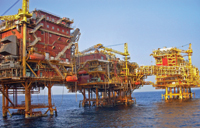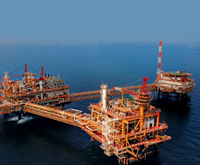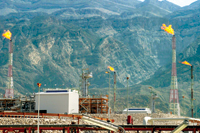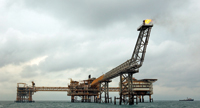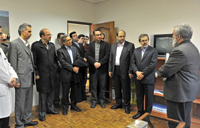
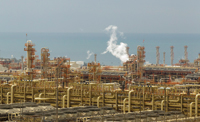 Iran on an all out programme to increase production from its fields
Iran on an all out programme to increase production from its fields
IRAN has officially announced it will increase its gas output and develop further oilfields in this financial year despite strict sanctions and lack of foreign investments even as its parliament (Majlis) has ordered the oil ministry to invest at least 10 trillion rials ($8.1 billion) in its joint oil and gas fields.
The amount would be allocated out of the oil ministry’s share of interest from its subsidiary companies.
Managing director of the Iranian Offshore Oil Company (IOOC) Mahmoud Zirakchianzadeh says that Iran’s total oil extraction from its joint oilfields in the Gulf, excluding the oil layer of the South Pars gas field has doubled in the past 12 months.
Iran has outpaced the UAE and Oman in tapping the Hengam and Salman joint oilfields, Zirakchianzadeh says.
“Iran is currently extracting 23,000 barrels of oil from Hengam oil field which is three times more than Oman,” he explains. “The amount would be raised up to 30,000 barrels in the next three months.”
The Hengam oil field is located about 45 km off Iran’s Qeshm Island in the Gulf and straddles the common sea border with Oman. Since the beginning of its development it has yielded about five million barrels of light crude oil.
Zirakhchianzadeh goes on to note that Iran’s share of extracting oil from the Salman field is also two times more than the UAE. He didn’t mention to the exact amount of extraction.
This is while the Majlis Research Centre reported that the total extraction volume of Iran’s neighbours from joint oil and gas fields is currently nine times more than Tehran’s share.
Iran shares 28 oil and gas fields with its neighbours. Tehran also claims to have another joint oilfield with Iraq.
In the Gulf region, Iran has 15 joint oil and gas fields with the UAE, Saudi Arabia, Qatar, Oman and Kuwait.
The UAE share of the joint fields is currently 136,000 barrels of oil per day, while Iran only extracts 56,000 barrels daily.
Saudi Arabia also extracts 450,000 barrels of oil from the joint fields while Iran’s share stands at 42,000 barrels.
However Iran’s main problem is the giant South Pars gas field. This is a part of a wider gas field shared with Qatar. The larger field covers an area of 9,700 sq km, 3,700 sq km of which are in Iran’s territorial waters (South Pars) in the Gulf. The remaining 6,000 sq km, referred to as the North Dome are in Qatar’s territorial waters.
 |
South Pars ... phases of the project behind |
The Iranian gas field contains 14 trillion cubic metres of natural gas, about eight per cent of the world’s reserves and more than 18 billion barrels of LNG resources.
Doha’s gas pump currently is two times more than Iran, while its extraction share from the field’s oil layer is 13 times more than Tehran. Iran is currently producing around 285 mcm per day of gas and 35,000 barrels of oil from South Pars. It is while Qatar extracts some 450,000 barrels of oil from the gas field’s oil layer.
Iran’s former President Mahmoud Ahmadinejad had said that the gas field’s production capacity would reach 480 mcm by September, equalling Iran and Qatar’s pace of tapping the joint field.
Iran has extracted 500 bcm of gas from South Pars over the course of 15 years.
Qatar announced last year that its total gas extraction from the field has reached one trillion cubic metres. Thanks to extracting gas from the joint field, Qatar is currently world’s largest LNG exporter. Its annual LNG exports stands at 77 million tonnes.
Due to the US-generated sanctions against Iran’s oil and gas sector, giant foreign companies have left the country’s energy projects. This has caused severe problems for Iran in regards to developing joint oil and gas fields.
Some of the phases of the South Pars gas field are way behind the schedule. For example the development plan of five phases of Iran’s giant South Pars gas field (phases 15-18 and phase 12) has entered its 66th month. These were supposed to come on stream by the end of current Iranian year (March 20) but none of them is complete.
Majlis Research Centre’s report claims that some countries have been tapping joint oil and gas fields without signing the required memorandums of understanding. The report also accuses some of the states of delaying the negotiations in order to continue extraction of oil and gas. Tehran believes that these governments should be fined by international courts.
Meanwhile, Iran will put the main phase of the South Pars natural gas field into operation in the next Iranian calendar month (August 23-September 22), the project manager of the phase 12 of the field says.
 |
Iran requires heavy investment to boost |
The phase 12 is projected to have an output of 84 million cubic metres of natural gas, 120,000 barrels of condensates and 750 tonnes of sulphur on a daily basis, says Masoud Rahbari. Some $7.746 billion of credit has been allocated to the development of phase 12, he says, adding that the project has progressed by 90 per cent so far.
The development of Iran’s southern natural gas field has been delayed due to the imposition of Western sanctions against the country’s energy sector.
National Iranian Oil Company managing director Ahmad Qalehbani says that three phases of the South Pars gas field, phases 12, 15, and 16, will be tapped in the current Iranian calendar year which will boost the country’s natural gas production capacity by 150 million cubic metres per day.
Reportedly, Iran is currently producing 300 mcm per day of gas from the South Pars. The South Pars/North Dome field is a natural gas condensate field located in the Gulf. It is the world’s largest gas field, shared between Iran and Qatar.
According to the International Energy Agency (IEA), the field holds an estimated 1,800 trillion cubic feet (51 trillion cubic metres) of in-situ natural gas and some 50 billion barrels of natural gas condensate.
Iran has signed an agreement with Iraq to deliver natural gas to its western neighbour, based on which 25 mcm of gas will be delivered to Iraqi Sadr, Baghdad and Al Mansouryah power plants through pipeline.
By signing the deal, the country will earn $3.7 billion a year in revenues, managing director of National Iranian Gas Company, Mohammad Javad Owji, says.
Iran has already completed the construction of its 227-km section of the pipeline to carry natural gas to Iraq, says Owji, adding that the 270-km Iraqi section will be completed in one or two months.
In March, Iran and Pakistan inaugurated a multi-billion-US dollar-gas pipeline project which will link Iran’s gas pipeline to that of Pakistan.
Iran has constructed 900 km of the 1,600-km-pipeline on its soil and both Iranian and Pakistani firms have undertaken the construction of the remaining part in Pakistan. When the project is completed by mid-2014 as scheduled, Iran will export 21.5 million cubic metres of natural gas to Pakistan on daily basis.
Iran is now exporting gas to Turkey and has swap deals with Armenia and Azerbaijan. Iran seeks to ramp up gas production for domestic energy consumption and increase gas exports to its neighbours.
Iran hopes that with more gas consumption at home it will be able to sell more oil internationally. Yet, with the strict western sanctions in place, Iran will face major difficulties in procuring the necessary funds to invest in its oil and gas sector.
Iran has officially announced that it will increase its gas output by 10 bcm (bcm) and develop more oilfields in a time of strict sanctions in this financial year, according to the National Iranian Gas Company (NIGC).
By tapping two new phases in the offshore South Pars gas field in the Gulf, Iranian officials hope to reach a total output of 190 bcm of gas in this Iranian calendar year, according to the Tehran Times. Iran’s overall gas output reached around 180 bcm of gas in the last Iranian year, according to Hassan Montazer Torbati, dispatching director of the National Iranian Gas Company (NIGC), as quoted by Shana, an Iran-based energy information service.
Iran’s domestic gas consumption by residential consumers and businesses, power plants, and industrial units reached 84 bcm, 39 bcm, and 30 bcm of gas, respectively, in the previous Iranian calendar year. Iran’s Pars Oil and Gas Company is expected to start production at the phases 15 and 16 of the South Pars gas field, according to Mohammad-Reza Zohairi, the company’s managing director.
Currently, Iran is producing 300 mcm per day (mmcmd) of gas from South Pars. Located in the Gulf, the South Pars field is the world’s largest gas field and is shared by Iran and Qatar (the North Field). It covers an area of 9,700 sq km, 3,700 sq km of which are in Iran’s territorial waters in the Gulf. The remaining 6,000 sq km, the North Dome Gas Field, is situated in Qatar’s territorial waters.
The South Pars field is divided into 29 phases, and has about 14 trillion cubic metres (tcm) of gas reserves, or about 8 per cent of total world reserves, according to Iranian sources. Iran has overall 137.6 billion barrels of proven oil reserves, and 29.61 tcm of proven gas reserves, according to Iranian officials.
In addition, Iran plans to develop three of its oilfields which are also located offshore in the Gulf in the current Iranian calendar year, according to Zirakchianzadeh. These fields include the Tossan, Esfandyar, and Soroush fields and are reportedly to be developed by Iranian contractors. According to Zirakchianzadeh, Iran has already launched projects in April 2012 to develop four oilfields in the Gulf to raise the total output from these fields by around 100,000 bpd in the current calendar. He adds: “Some $9 billion-worth of contracts were signed last year to develop Salman, Lavan, and Forouz B fields.”
Overall, Iran also introduced plans last year to develop the first phase of development plans of the Yadavaran, Sarvestan, Saadatabad, Hengam, Forouzan, Reshadat, Aban, and Paydar oilfields between July 2012 and August 2013 to boost its oil production from those fields by 175,000 bpd. Overall Iran’s ambition is to boost output by 500,000 bpd over the current calendar year and to increase its total production by 1.5 mbpd by 2016, according to Iran’s former Oil Minister Rostam Qasemi.
Iran’s official figure for actual oil output capacity stood at 4.2 mbpd but actual production in Iran, which has been hit by a series of international sanctions targeting its energy and financial sectors, is estimated by industry sources at 2.7 mbpd of crude in March.
Iran’s ambitions to boost oil and gas production, despite the US and EU sanctions, is ambitious. The sanctions on Iran’s oil exports have reduced the country’s oil-based revenues and its lack of access to foreign currencies resulted in further pressure on its own currency with inflation reaching almost 40 per cent.
From its perspective, Iran is seeking to increase natural gas production for domestic consumption but also for exports as a means to reduce its reliance on crude sales as the country “witnesses a change in the revenues of the country from crude oil to natural gas,” according to Owji.
He seeks to triple gas shipments across the region. Iran has signed deals with Turkey, Iraq, and Pakistan. Overall, Iran expects to increase natural gas exports to about 100 mmcmd from a current 35 mmcmd of natural gas exports.
He adds that Iran plans to sell 25 mmcmd of natural gas to Iraq in September this year via a new pipeline. Iran has also started work on the cross-border leg of the $1.5 billion Iran-Pakistan gas pipeline on the Pakistani side of the border to export around 21.5 mmcmd of gas to Pakistan over a period of 25 years. Iran’s gas exports have totalled under 10 bcm per year in 2012, according to Owji.
The western sanctions have severely limited Iran’s oil exports over the last year and restricted Tehran’s access to foreign investments. Thus, it remains to be seen how Iran will overcome what will be a Herculean task to implement its ambitious gas and oil projects. The government plans to invest about $500 billion in Iran’s oil industry by 2025 and $200 billion by the end of the Fifth Five Year Economic Development Plan (2010-2015).
But even the country’s deputy economy minister Davoud Manzour acknowledges that procuring funds is the key problem for Iran’s oil and gas exploration and development projects as these require special technology, equipment and financial resources.
While Iran managed to attract $70 billion from domestic and $43 billion from international investors during 2006 and 2011, since the tightening of sanctions last summer, things look rather difficult for the country in the year ahead.
As the government plans to invest around $20 billion annually in Iran’s hydrocarbons sector, the Iranian parliament approved the issue of $20 billion in bonds of which $10 billion would be raised by the Ministry of Petroleum and the other half by the Central Bank of Iran (CBI).



















































































